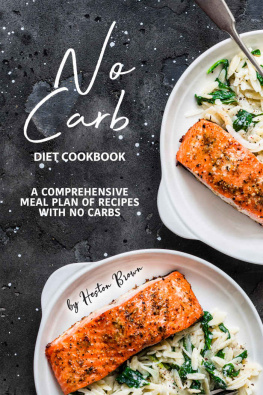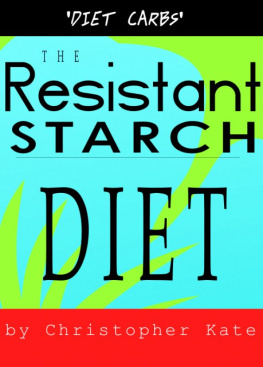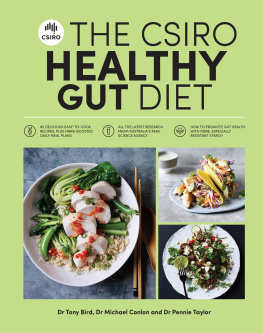

To my dad, OH
Acknowledgments
T HEREs NO I in book, so first thanks go to anyone I inadvertently left out of this acknowledgmentyou know Ill think of you immediately after this goes to print.
My personal support team, Rachel and Yael, deserve the most credit. Mom, your input was invaluable. Other David, always a pleasure working with you; you turned my recipe concepts into delicious reality. And Id have gone nowhere fast without my wonderful friends (and stereo nutrition PhDs), Mark and Kantha. Or either of the two Andreassister and editorwho helped immensely. (The latter earns extra kudos: You truly redefine going above and beyond the call of duty; I thank you greatly.)
Special thanks to all the volunteer test panelists who agreed to follow the RS diet and act as consultants during the beginning stages of this project.
To Audrey and everyonestudents and teachersin the undergraduate and graduate Departments of Nutritional Sciences at the University of Texas at Austin 1991-95, my heartfelt thanks for your patience. Thanks, too, to Dave F., Seta, and Hope, for each of your very different contributions.
But at the end of the day, without you, Rhonda, this book absolutely would not existI mean that most sincerely and humbly.
Contents
Introduction
W elcome to a truly different approach to weight loss and long-term weight maintenanceone that, thankfully, upends the conventional wisdom about carbohydrates. I say thankfully because those of us who love our breads, pastas, and cereals have long been made to feel guilty about our enjoyment of these comforting foods, especially if we were trying to slim down. With this book, we leave behind the fad diets that didnt take into account the foods we like to eat, didnt explain how our favorite foods could work for us, and just plain didnt work.
For generations, the study of diet and nutrition has focused on the three so-called macronutrients: carbohydrates (which include starches, fiber, and sugars), fats, and proteins. Most eating plans for weight loss or weight maintenance make a case for eating more or less of one of the main nutrients. Eat carbs. Dont eat carbs. Eat less fat. Eat more protein. Yet decades of science and hundreds of diets later, we are facing epidemic obesity and a global type 2 diabetes crisis. Clearly, what weve been doing hasnt been working.
The fact is, all three macronutrients have very specific functions in our bodies. Eliminating one or another can set us up for a host of health problems, not to mention weight gain. Fats are a good example: Once the bane of dieters, theyve undergone something of an image makeover, thanks to studies showing that certain fats contribute to weight loss and good health. Now similar redemption may await carbohydrates, thanks to a particular type of carb known as resistant starch, or RS.
Recent research has opened our understanding of fundamental differences among carbs, especially with regard to how our bodies metabolize and use them. As nutrition science is showing, resistant starch is particularly favored by the body as an optimal source of energy, satiety, and glucose regulation. And it has been right under our noses all along.
As we learn more about resistant starchincluding which foods are the best sources and how various cooking methods affect itwe are compelled to rethink the role of carbohydrates in weight loss and weight maintenance. The fact is, carbs are okay. And if eating the right kinds of carbsnamely, those rich in resistant starchcan help us to take off and keep off those extra pounds, thats all the better!
Weight Loss Made Better
Behind any effective weight loss planincluding this oneis a very simple equation: calories in < calories out = weight loss. The question is whether a diet equips you to easily achieve that goal by allowing you to eat in a way that satisfies your taste buds and your appetite while delivering a good mix of essential nutrients. In other words, a diet that works has to be a diet you can live with.
The Skinny Carbs Diet is not just about increasing your resistant starch intake, though thats central to the plan. Its about getting more fiber, eating foods that energize you, and learning to make healthy choices that support your weight-loss efforts. And once you reach your goal, youll continue eating this way not because you have to, but because you want to.
Because this diet will feel less restrictive, it will require less effort than most weight-loss plans. Youll be less likely to fall into a pattern of yo-yo dieting and instead make real lifestyle changes. Over time, this will become your natural eating style.
The weight loss that comes from adding resistant starch to your diet is different from that of standard calorie-restrictive diets. In a 2004 study led by Janine Higgins, PhD, of the Center for Human Nutrition at the University of Colorado Health Sciences Center in Denver, people who consumed 5.4 percent of their total carbohydrate intake as resistant starch experienced a 20 to 25 percent increase in fat metabolism. This rate held steady throughout the day.
Resistant starch fuels weight loss by burning both body fat and visceral fat (aka belly fat), which surrounds your internal organs. This hidden fat has been shown in some studies to be a marker of increased disease risk. RS also enhances your bodys ability to metabolize nutrients. Because it helps you feel full, you tend to consume fewer calories at each mealand remember, taking in fewer calories than you burn is the key to weight-loss success.
Authors Note
I came to nutrition and dietetics after more than 15 years as a professional chef. My decision to enter the nutrition field stemmed from the discovery that few registered dietitians at the time appeared to possess anything more than a rudimentary knowledge of food from a culinary standpoint. In fact, I was dismayed to learn that far too many RDs actually held an adversarial attitude toward food! This revelation propelled me through the 5 years of university study and clinical practicums required to become a registered dietitian.
Its often been said by my peers who get it that people eat food, not nutrition. Ask someone to recall a favorite food memory from his or her youth and I guarantee that it wont be the time that Grandma visited and spent the whole day in the kitchen making fat-free, vitamin-infused rice cakes spread with tofu cream cheese.
The field of nutrition and dietetics has changed a great deal since I came aboard. Still, there are pockets of resistance among dietitians who put nutrition ahead of flavor, who consider food and cuisine to be separate entitieswho just plain dont like food. But the idea that Ive promoted during my years as a chef-dietitian remains the same: Food is to be enjoyed and celebrated, not feared and isolated. I hope that comes through in this book, especially in the recipe concepts that David Bonom turned into amazing and delicious, easy-to-make recipes.
As I collected my research for this book, what impressed me most is that nutrition research seems to finally be catching up with our food preferences. Weve reached a point where good nutrition can meet both our needs and our wants, with foods we love to eat forming the backbone of a plan to help us lose weight and have more energy, all the while reducing our risk of diabetes, cancer, and heart disease. That is what every dietitian should be striving for, after all.












